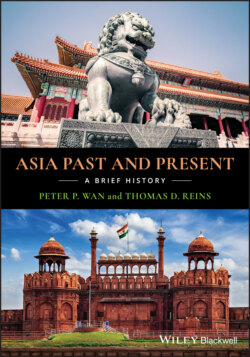Читать книгу Asia Past and Present - Peter P. Wan - Страница 33
China Enters the Iron Age: The Eastern Zhou Dynasty, 770–221 BCE
ОглавлениеA non‐Han nomadic tribe captured and sacked the Zhou capital and killed its king. The succeeding Zhou king relocated his capital from near modern Xian eastward to Luoyang. This move marks a divide between the Western and Eastern Zhou Dynasties. As well, the use of iron appeared in China in the eighth century BCE. It was far superior to bronze for making tools and weapons, and it was readily available and inexpensive. Farmers began to make affordable iron tools, such as plowshares, hoes, shovels, and picks that were hard, strong, and good at holding a point or blade. And when they harnessed a powerful ox to an iron plow, they could open up virgin land, dig deep pits and furrows, and create waterways for irrigation and drainage. It was an agricultural revolution. As a result, agricultural production reached new heights and population growth followed. Iron also made agriculture more practical in the more difficult terrain of central and southern China, while more regular rainfall reduced the necessity of elaborate irrigation systems of the North China Plain.
The relocation of a capital would happen during many dynasties. It was usually prompted by one of two factors. One was to escape raids and encroachment by nomadic tribes, which usually came from the north and the west. The second was to move to a region of greater natural resources, greater wealth, or a larger population, which was often to the east and the south. In either case, the new capitals would be to the east or south of the old one. Hence, in chronological order, Western and Eastern Zhou, Western and Eastern Han, and Northern and Southern Song.
The agricultural revolution provided surplus food and goods, which were traded on the market. Lively trading created a demand for a larger volume of currency, so iron coins were added to copper coins to meet the demand. The flow of goods from one region to another increased the wealth of all parties involved and improved their standards of living. Small, closed, and self‐sufficient communities began to reach out and interact with others. These factors generated a commercial revolution.
The dramatic increase and spread of wealth across the land upset the old balance of power. The “Sons of Heaven” of the late Zhou Dynasty watched haplessly as power slipped from their hands. They would never be able to reestablish the kind of centralized authority enjoyed by their predecessors. As their power declined, their vassals (aristocrats and local lords) asserted ever‐greater regional autonomy. Soon the vassals were only paying lip service to the “Son of Heaven,” who now ruled only in name. The feudal system was in a state of disintegration.
The regional powers, now free of the restraints placed on them by the Zhou king, began invading each other’s territories. But they were sitting on volcanoes of their own, for their subordinates were also scheming to topple them. Consequently, this was a time marked by extreme examples of intrigue and violence within and between the powerful regional warlords. Out of a hodgepodge of big and small warlords fighting for control of land, population, and hegemony, seven hegemons emerged standing tall and strong. They headed regional states, not city‐states, where they built centralized monarchies. These emerging hegemons were called the “Seven Overlords of the Warring States,” who launched the Warring States Period, ca. 500–221 BCE.
Chinese who lived in times of declining central authority have never had anything good to say about their times, and historians have traditionally considered them bad times. But history has shown that, while they have their terrible downsides, the absence of a stifling central authority can also create an environment that induces great outbursts of energy and creativity. Late Zhou is a case in point.
